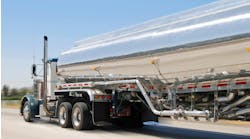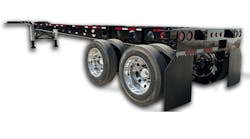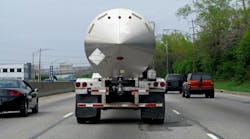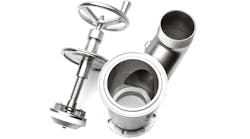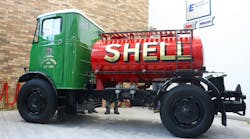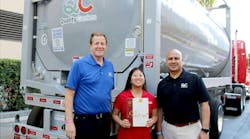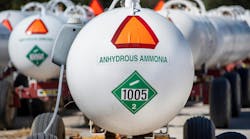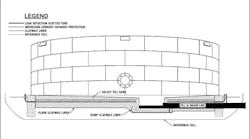ALAN Watson, an internationally recognized expert in storage tank lifting and foundations, said the best advice he can give owner-operators is to stress quality control over everything else.
“The best engineer in the world can do drawings,” said Watson, president and owner of AR Watson Inc. “But unless you install it as he's drawing it, you'll create problems.”
Watson was part of a panel that gave a presentation, “Tank Foundations and Bottoms: Perspectives on Engineering Design” during the International Liquid Terminals Association's 30th Annual International Operating Conference held May 24-26 in Houston, Texas.
Watson described a number of poorly constructed and maintained storage tanks that resulted unstable tanks or dangerous operating conditions. Problems included grass, moss, or trees growing out from under the tank; a tank floor laid on river stone; ground outside the foundation that is cracked; ground bearing pressure under concrete ringwall; timber railway ties laid under shell holding moisture; uneven foundation around tank; tank shell flattening out at the top of the tank; dike wall out of level; concrete ringwall sloping under tank; moisture held in the foundation; welding of the tank floor not to any code.
He went into specific detail about some of the problems:
- Tank settled below ground
“You look around a tank like this and you can see what the problems are. You don't have to be a rocket scientist to understand. When you see something like this, you know there is going to be corrosion.”
- Tank shell has edge settlement
“You're losing capacity over the whole top of the tank. So you're losing product storage.”
- Water pooling around the ringwall foundation
“They lifted tank up three to four inches. We've seen this on a brand-new foundation. The ground outside the foundation is cracked. They didn't put a compactor on the ground, so a brand-new tank is going to fail because moisture or water is underneath. You have to slope water away from foundation.”
- Tank floor annular plate is starting to delaminate
“They set the steel on concrete. Now we have delamination. The problem in coastal areas like Key West and Hawaii is salt spray coming onto the tank, and condensation carrying salt down under the tank. You've got to seal between the concrete and tank itself.”
- Uneven foundation settlement
“It causes the top of the tank to become oval and jam the floating roof.
On a 40-foot-high tank, the top of the tank can be off by over 28 inches. It's a foundation problem, not a tank problem.”
- Floating roof jams on the way up
“In Providence, Rhode Island, they built two tanks on a two-foot-thick slab, and the tanks were tied into that slab. There's only 10 feet separation between tanks. Both fell toward each other and brought the top of the wall in. That wall was eight feet high and had tilted probably 9-10 inches. They built buttresses to hold the wall up. It wasn't a problem with the wall. It was settlement under the tank.”
- Tank floor annular space is hidden
“Insulation is holding moisture. They put insulation right over the annular and over concrete it was sitting on. You couldn't see the annular. What happens to moisture behind the insulation? It went down and couldn't get out. Now that corroded the whole area, so in time it would fail. I've always said the annular on the tank must be exposed at all times so the operator can walk around the tank and can see with his eyes. He doesn't have to read any documents.”
- Bottom shell bulges out
“If you see the building effect, called an ‘Elephant's Foot,’ that's because the center has gone down farther than the shell. The excess steel is gone, which creates that bulge.”
- Poorly constructed or inadequate foundation material
“The foundation material is sloppy. When it's at ground level, it becomes a major problem. A 10-year-old tank in Texas had a beautiful concrete ringwall sitting up out of the ground. But when they built the ringwall, they didn't put in any holes so moisture could get out from under the foundation, so it's just like a swimming pool underneath.”
He said the “double bottom” was developed in the 1980s as the only viable secondary containment method. With the old steel floor and a new steel floor spaced apart with sand or concrete, the oxygen and moisture “makes a perfect battery cell and the new floor becomes the sacrificial anode. The new steel floor corrodes at a rate four times faster than the old floor. Cathodic protection (CP) must be designed and installed by experienced contractors or may result in increasing the rate of corrosion of the tank floor. Any change in the amount of moisture in the foundation material will cause the resistivity of the material to change and this may result in the CP breaking down.”
If all three elements of the corrosion triangle — air, steel, moisture — are present, corrosion can occur.
“In some cases, where oil impregnated fiberboard or oil sand has been used, nature has done its work and eaten the oil out of the sand,” he said. “This can reduce the resistance of the sand and this condition has proven to accelerate corrosion.
“I believe in NDT (non destructive testing) inspections, but they have limitations and flaws and cannot inspect 100% of the tank floor. This testing cannot inspect the critical zone around the shell to annular weld, lap joints, under the roof columns, around tank sumps. Sometimes packed rust shows up as good metal.
“We have found that many of the problems with above-ground storage tanks start at the foundations. Tanks not built on a proper foundation are bound to fail. When built on good foundations, tanks have lasted 50 and more years.”
Alan Geis
Tank and facilities coordinator on asset integrity team
Colonial Pipeline Company
Geis listed these design features for Colonial tank floors and foundations: concrete ring-wall foundation; 5/16" thick A36 cone down (drain-dry) floor; 3/8" thick A36 modified annular ring; 9'6" center sump with underground fill/drain line; thin-film epoxy coating on floor topside and lower 2' of first shell course; impressed current cathodic protection with reference cell; Claymax external liner; select fill material (12") compacted to 98% modified proctor; slotted tube leak detection for floor and sump.
Benefits associated with the Colonial design include the ability to handle multiple product grades within one tank shell; increased storage capacity; minimal sediment/water accumulation; minimal topside floor corrosion; enable high input and output rates; and extended inspection intervals.
Challenges associated with the design: fatigue cracking issues; maintain compaction of select fill material; deck failure issues; floor oil canning; and static electricity build up.
Hector Gonzalez
Corrosion/welding manager
NuStar Energy
Gonzalez provided an extensive list of design features for NuStar tank floors and foundations:
- Concrete ringwall foundation based upon geotechnical report and engineering design. Possible need for geopiles depending on soil conditions and loading. Sometimes it is necessary to replace down to a certain depth with new materials to reduce the likelihood of settlement. Maintain the ringwall one foot above ground level.
- Leak detection ports are provided in the ringwall to display leaking product should that occur.
- Impressed current cathodic protection system with reference cells and remote rectifier monitoring units are used to protect against soil side corrosion and monitor the effectiveness of the CP system.
- Claymax or HDPE liners are used as secondary containment. If HDPE is used, then the CP system changes to anodes located on top of the liner so the liner doesn't shield the CP system.
- Bottom thickness and layout is dependent on product type, soil conditions, and heel requirements. NuStar uses flat bottoms, cone-up bottoms, cone-down bottoms, shovel bottoms, and Mesa type bottoms when reducing heels is necessary.
- Wick-drain systems help prevent potential long-term settlement problems.
- Minimum 3/8" thick annular ring is used, with material type dependent on the location where the tank is to be built. Colder climates require higher group materials due to increased toughness being necessary.
- Sumps are sized and located in accordance with the current edition of API 650.
- Internal coating on the bottom and three feet up the shell and internal anodes are used in conjunction with one another to reduce product side corrosion.
- Fill sand used to shape how the bottom will lie is composed of low chloride, near-neutral pH, and high-resistivity sand. Care is taken to ensure that there are no contaminants in the sand such as lumps of clay, rocks, or any other debris that may result in aggressive corrosion.
- Inspection of the bottom welds, and shell to bottom welds is performed in conformance with the current edition of API 650/653 depending on if the bottom is for new construction or retrofitting an existing tank.
- Striker plates under roof legs.
- On annular plates, for insulated tanks, the chime area is exposed for inspection purposes by installing an insulation support ring up several inches from the bottom.
Benefits associated with the NuStar design:
- Settlement is minimized since the soil condition and loading are known and taken into account during the design of the foundation.
- All water draw off lines are contained within the tank so leaking lines running under the tank aren't an issue.
- Addition of the annular ring provides for added strength in a high-stress area.
- Internal anodes and coating used in conjunction with one another effectively mitigate the threat from product-side corrosion.
- Impressed current cathodic protection system with reference cells effectively mitigates the threat from product-side corrosion and the bullhorn units will immediately notify the correct CP technician should the system go down for whatever reason.
- Bottom designs are selected to reduce heels and localize water for removal from the sump.
Challenges associated with the NuStar design:
- Additional time to take soil samples and have the geotechnical report put together.
- Additional costs to use multiple mitigation methods for reducing product side corrosion threats.
- In some locations it is difficult to find sand meeting all requirements.
Wardlaw Witherspoon
Staff engineer
International-Matex Tank Terminals
Design considerations of IMTT concrete ringwalls include:
- Soil conditions. “We have very poor conditions, so one of first things we do is hire a geotechnical engineer.”
- Ringwall size. “What is the specific gravity of the product to be stored? What are the soil conditions?
- Secondary containment. “We mainly use HDPE liners with leak detection on all new construction.”
- What are you storing in the tank? Will the heated tanks burn up the liner?
- Apply compacted structural sand to 98% maximum dry density in 12-inch lifts. Sand actually contributes to overall weight of the foundation.
- Masonry sand. “We put it underneath the tank floor and in our double bottoms. We find it's less corrosive to the tank floor. We have minimal requirements of electrical resistance of 50,000 ohms/cm and pH of 7.0.”
- Tank hydro. “Probably the most important step because of settlement. Stage loading and hold times, recommended by a geotechnical report. This is normally a lengthy and slow process but also very important.”
- Tank settlement. “We strive for uniform settlement, but sometimes have planar tilt that goes beyond differential settlement as per API 653 tolerances.”
- Tank re-leveling. “We normally include it in the budget just in case it might happen.”
Other IMTT tank foundation design considerations:
- Wick drains. Prefabricated vertical drains installed in the soil that provide a more stable and efficient settlement process.
- Reinforced soil. Grouted piles that reinforce and share the load with the surrounding soil.
- Anchor bolts can be used on tanks with internal pressure and seismic loads.
- Piles and pile caps for storage tanks with excessive product specific gravity.
- Earth and crushed stone for tanks that have floated off of their foundations.
David Clark
Project engineer
Kinder Morgan Terminals
Clark said that when concrete ringwall is the foundation choice, the elevation of the bottom should be significantly above typical rainwater collection.
He described a Kinder Morgan facility built in 1987 with 40 tanks and said there have been zero tank-bottom failures due to corrosion. All tank inspections have shown zero observed corrosion in 15-20 years. All tank bottoms still have a nominal 0.248" to 0.255" remaining.
“Consideration should be given to a full concrete pad foundation,” he said. “If done right, it eliminates corrosion and settlement. Proper installation of a coating on the top of a concrete pad handles the duties of an undertank liner and leak detection. With respect to capital and future expense, concrete should be considered.”
He said that in considering a concrete slab, there are cost variations. Costs that are a wash (more or less): site grading and compaction; pilings and other reinforcement as required; amount of framing, labor, and concrete for the ringwall. Costs that are added: capital costs for additional concrete and labor to install; capital costs to install coating on top of the concrete pad; and trucks arriving and crew working.
Costs that are eliminated: capital costs for undertank liner, leak detection, and cathodic protection; expense costs for decades of cathodic protection surveys and associated paperwork.
With replacement tank bottoms, he said there are product side corrosion issues (product interaction, sediment on tank bottom) in the form of water on the tank bottom and internal flows. Soil side corrosion issues include general corrosion, pinpoint corrosion, and lack of proper water drainage.
“Consideration should be given to internal tank liners,” he said. “Product side liners should be considered if material may interact with carbon steel. HDPE liners with leak detection and cathodic protection should also certainly be considered. Consideration should be given to installing 5/16" or 3/8" and clean bank sand. A thicker bottom is the only solution that increases protection for product side and soil side. A leak detection and HDPE liner are helpful in detection and remediation of the leak.”
He said a replacement bottom with increased thickness should be considered.
Costs that are a wash (more or less): material costs of .250 steel; labor for welding out bottom and corner weld; and costs for sand installation. Costs that are added: cost to remove and dispose of old bottom plate; costs for increased thickness; possible costs to remediate under the tank. Costs that are eliminated: costs for cathodic protection, leak detection, and undertank liner; costs to raise or modify shell nozzles and manways; and costs to raise and modify piping and piping supports after tank nozzles have been raised. ♦
